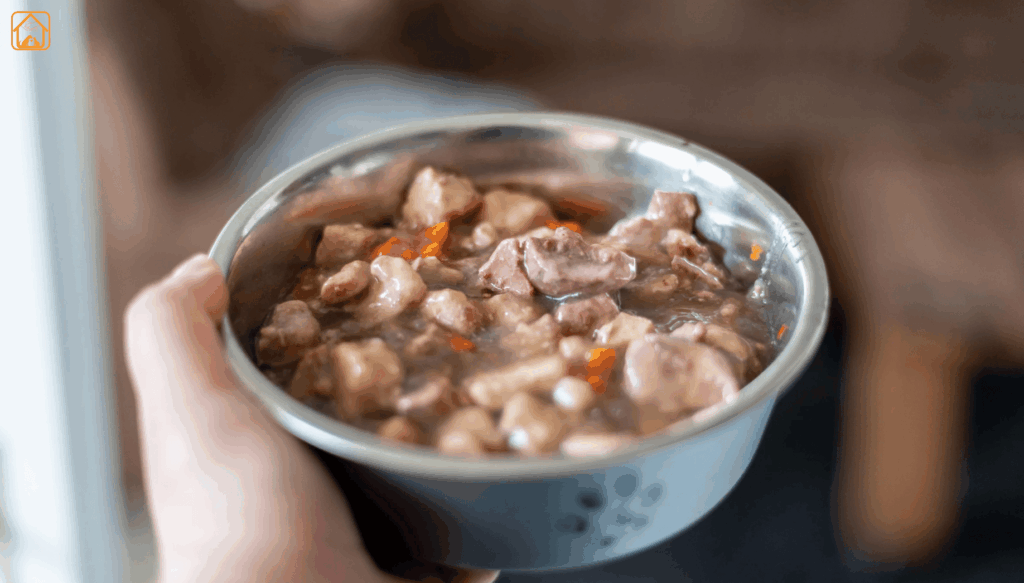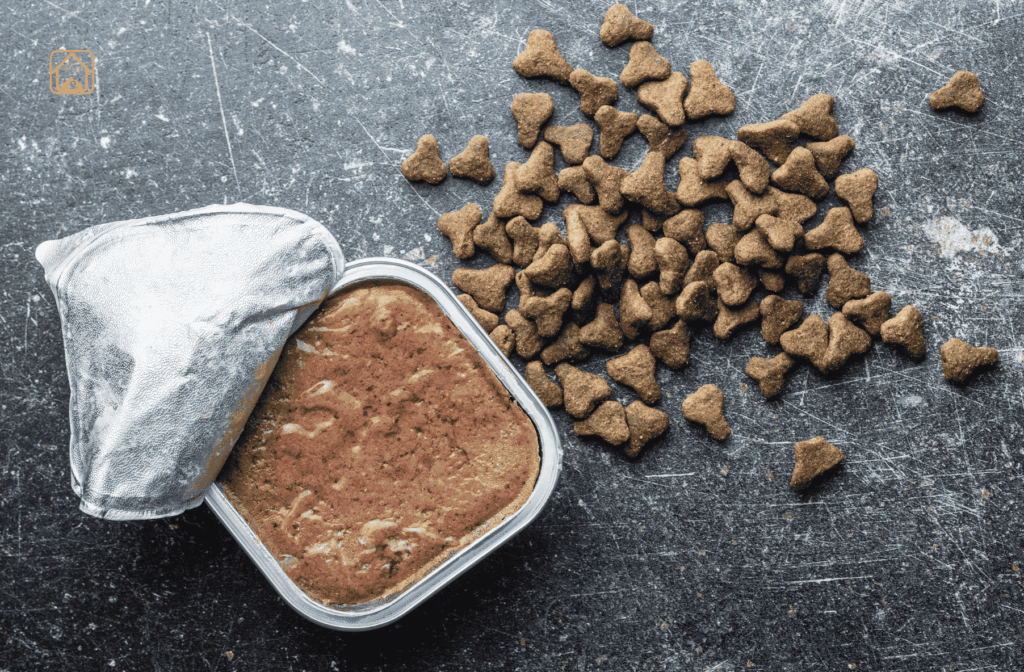Understanding the Differences: Wet vs Dry Dog Food
When it comes to wet vs dry dog food, the real difference isn’t just about texture. It’s about what’s inside, how it’s made, and how it fits your dog’s unique needs. Let’s break down the basics so you can see the big picture.
- Moisture Content: Wet food (canned or pouch) is packed with water, typically about 70-80% moisture. Dry food, on the other hand, contains only 8-12% moisture. This means wet food feels juicier and can help hydrate dogs.
- Processing: Wet food starts with ground meat, grains, and added vitamins, blended into a stew, then cooked and sealed for freshness. Dry food is created by mixing ingredients into a dough, cooking, and shaping it into those familiar kibble pieces.
- Serving Style: Wet food is often more aromatic and flavorful, making it appealing to picky eaters, seniors, or dogs with dental issues. Dry food is crunchy, stores easily, and can be left out longer, perfect for grazers.
- Convenience: Dry dog food is easy to keep, measure, and feed. It won’t spoil if left out all day, making it ideal for busy schedules. Wet food, while easy to serve, needs refrigeration after opening and can’t sit out for long.
- Cost: Generally, dry food is more budget-friendly and available in bulk bags, handy for multi-dog households. Wet food tends to be pricier per serving, especially for large breeds.
Both wet and dry dog foods can be complete and balanced, providing the nutrients dogs need at every life stage. The real question is which one will fit your dog’s health, age, habits, and your lifestyle best.
| Feature | Wet Dog Food | Dry Dog Food |
| Moisture Content | 70-80% | 8-12% |
| Shelf Life (unopened) | 1-2 years | Up to 1 year |
| Dental Benefits | Minimal | Helps reduce tartar |
| Ease of Portioning | Easy, often pre-portioned | Very easy, scoop by weight |
| Palatability | Highly palatable | Varies, some dogs love crunch |
| Price | Higher per serving | More economical |
| Storage | Refrigerate after opening | Store in cool, dry place |
Nutritional Comparison: Ingredients, Moisture, and Calories
Let’s get down to what really matters in the debate of wet vs dry dog food. Both can provide high-quality protein, healthy fats, and essential vitamins and minerals. However, their composition, and how much your dog eats, varies.
- Protein: Wet food typically contains more animal protein by percentage which can be great for active dogs, puppies, or those needing a protein boost. Dry food often balances protein with carbohydrates for energy.
- Fat: Both wet and dry options contain fats for energy and a shiny coat. Wet food sometimes has a higher fat content, which gives it that tempting aroma.
- Carbohydrates: Dry food usually contains more grains or starches to form the kibble structure. This isn’t a bad thing, carbs provide energy and fiber, but if your dog has allergies or sensitivities, you’ll want to check labels closely.
- Vitamins & Minerals: Quality brands ensure both types are fortified, so your dog gets essential nutrients, regardless of texture.
- Calories: Dry food is calorie-dense, so you feed less by volume. Wet food’s water content means bigger portions for the same calories, which can help dogs who need to feel fuller.
Here’s a quick visual for comparison:
| Nutrient (Typical) | Wet Dog Food | Dry Dog Food |
| Protein | 8-12% (as fed) | 18-30% (as fed) |
| Fat | 5-8% (as fed) | 8-22% (as fed) |
| Carbs | 1-10% (as fed) | 30-60% (as fed) |
| Moisture | 70-80% | 8-12% |
| Calories/cup | ~350 | ~400-500 |
For a deeper understanding of what goes into a healthy canine diet, be sure to read our article on Dog Nutrition.
Advantages and Disadvantages of Wet Dog Food
Pros of Wet Dog Food
- High moisture content promotes hydration, helpful for dogs with urinary or kidney concerns.
- More palatable and aromatic, tempting even picky eaters or dogs with decreased appetite.
- Easier to chew and swallow, especially for seniors or dogs with dental problems.
- Can provide a feeling of fullness, which may help with weight management.
Disadvantages of Wet Dog Food
- Shorter shelf life once opened; needs refrigeration.
- Can be messy, think “beard dips” and food stuck on whiskers.
- Generally more expensive per meal compared to dry food.
- May contribute to dental plaque if used exclusively without dental chews or brushing.
Honestly, I’ve had my kitchen floor wear more wet food than my dog’s mouth during his “learning to eat from a bowl” phase. It’s a bit of a trade-off!
Advantages and Disadvantages of Dry Dog Food
Pros of Dry Dog Food
- Convenient to store, portion, and leave out, ideal for grazers.
- Crunchy texture can help reduce tartar buildup, supporting dental health.
- More cost-effective and bought in bulk, saving money in the long run.
- Easy to use in food puzzles and for training rewards.
Disadvantages of Dry Dog Food
- Lower moisture content; not ideal for dogs with certain kidney or urinary issues.
- Harder for dogs with dental disease or missing teeth to chew.
- Some picky eaters may ignore kibble, especially if it’s not fresh.
- May have more fillers or less palatable flavors compared to wet food.
Feeding Dogs with Sensitive Stomachs
Is wet or dry food better for dogs with sensitive stomachs? It depends on the individual dog. Wet food is often gentler on digestion because of its softer texture and higher moisture, but some formulas can be rich or too fatty for delicate tummies. Dry food may include added fiber or probiotics, supporting digestive health if your dog tolerates grains and kibble well.
If your dog is prone to tummy troubles, look for foods labeled for “sensitive stomachs” and introduce new diets slowly. Consulting your vet is always a smart move here.
Mixing Wet and Dry Dog Food: Benefits, Risks, and Calculating Amounts

Mixing wet and dry dog food can give your dog the best of both worlds, flavor and crunch, hydration and convenience. Plenty of dogs love the variety, and it can make meals more exciting.
Benefits of Mixing
- Enhances taste and texture for finicky eaters.
- Boosts hydration from wet food while keeping calories in check.
- Lets you adjust nutrition for special needs (e.g., joint support from kibble, added hydration from canned food).
Risks & How to Calculate Amounts
- Risk of overfeeding: It’s easy to give too many calories when combining foods. Use a mixing wet and dry dog food calculator or ask your vet for exact amounts based on your dog’s weight, age, and activity.
- Transition gradually to avoid stomach upset.
Quick tip: Always check the calorie content per cup or can and adjust portions to fit your dog’s daily needs. When in doubt, your vet can help with a custom feeding plan.
Cost Comparison: Wet vs Dry Dog Food
If you’ve ever gulped at the checkout after buying a stack of cans, you know wet food can be pricier than kibble. Dry dog food usually costs less per meal and is sold in bigger bags, making it more budget-friendly, especially for larger breeds. Wet food, however, might be worth the extra cost for dogs needing special care or with poor appetites.
- Dry food: Cost-effective, easy to store, less waste.
- Wet food: More expensive per serving, but offers unique benefits.
Choosing Based on Life Stage: Puppies, Adults, and Seniors
Not all dogs need the same food at every age or stage. What works for a bouncy puppy might not suit a wise old senior or a pup with a sensitive stomach. Here’s how I help friends and clients figure it out, plus a few stories I’ve picked up along the way.
Puppies
Puppies grow fast and need food that gives them lots of energy. Wet food is helpful when they’re moving off milk, but dry food or a mix of both is best as they grow. Choose puppy food that helps build strong bones, joints, and a healthy brain.
Adult Dogs
Once they’re grown, dogs need steady energy and balanced nutrients. Active dogs might need more calories from dry food, while less active ones can do well with wet food. Mixing the two can make meals more fun and still keep their diet balanced.
Seniors
Have you ever noticed your old dog taking a long time to eat or not finishing meals? Seniors often struggle with dental issues, arthritis, or fading senses. Wet food or even softened kibble can be a game-changer. Look for formulas with glucosamine, chondroitin, and plenty of antioxidants.
Special Health Conditions
- Sensitive Stomachs: Is wet or dry food better for dogs with sensitive stomachs? Usually, wet food is gentler and easier to digest, but some dry foods are formulated for easy digestion, too. Always transition slowly and watch for signs like loose stool or gas.
- Allergies: If your dog has food allergies, stick to limited-ingredient diets, available in both wet and dry forms. Sometimes, mixing is helpful if one type is more palatable.
- Weight Management: Wet food can help dogs feel full with fewer calories, but kibble makes portion control easier. For overweight dogs, talk to your vet before making big changes.
- Dental Concerns: Dry food can help reduce plaque, but it’s not a cure for dental disease. Dogs with missing teeth or sore mouths may do better with wet food or soaked kibble.
One of my neighbors, Manoj, had a tough time getting his senior dog to eat. For weeks, nothing seemed to work. Then he tried mixing a bit of warm water and a spoonful of wet food into her prescription dry kibble and like magic, she started eating again. Sometimes, it’s all about paying attention and finding what works best for your dog.
Here’s a quick age-based cheat sheet for wet and dry dog food choices:
| Life Stage | Best Food Type | Why? |
| Puppy | Wet, softened dry, or combo | Easy to chew, gentle on tummies, varied textures |
| Adult | Any (as needed) | Can handle all textures; pick based on health and preference |
| Senior | Wet or mixed | Softer, more aromatic, hydrating, gentler on teeth |
FAQs: Wet vs Dry Dog Food
1. What are the main differences between wet and dry dog food?
Wet dog food has higher moisture, softer texture, and is usually more aromatic, while dry food is crunchy, lower in moisture, and more convenient to store. Both can be nutritionally balanced when chosen wisely.
2. Are there disadvantages of wet dog food I should know?
Yes, wet food spoils quickly once opened, can cause messes, costs more per meal, and may contribute to dental plaque if dental hygiene isn’t maintained.
3. What are the disadvantages of dry dog food?
Dry dog food is less hydrating, can be hard for dogs with dental problems to chew, and some picky eaters may refuse it. Some kibble brands may also use more fillers.
4. Is wet or dry food better for dogs with sensitive stomachs?
It depends on the cause of sensitivity. Wet food is easier to digest for some dogs, but others do better with a simple dry food formula. Choose diets labeled for “sensitive stomachs” and consult your vet.
5. Can I mix wet and dry dog food?
Absolutely. Mixing can offer variety and balance. Just be careful to calculate total daily calories to avoid overfeeding, and introduce changes slowly.
6. How do calories compare: wet vs dry dog food?
Dry food is more calorie-dense, so you’ll feed less by volume. Wet food requires larger portions to meet calorie needs. Always check the label for serving size recommendations.
7. Is one type better for puppies or seniors?
Puppies often benefit from wet food’s texture and palatability, while seniors may prefer it if they have dental issues. Otherwise, high-quality dry foods made for their life stage work well, too.
Conclusion
Choosing between wet vs dry dog food isn’t about picking a “winner”, it’s about finding what works for your unique dog and your family’s lifestyle. Don’t be afraid to experiment, mix things up, and adjust as your dog grows or their needs change.
If you’re ever unsure, your veterinarian is your best partner. They know your dog’s health history and can help you fine-tune every meal. And hey, trust your instincts, too. You know your dog better than anyone.



